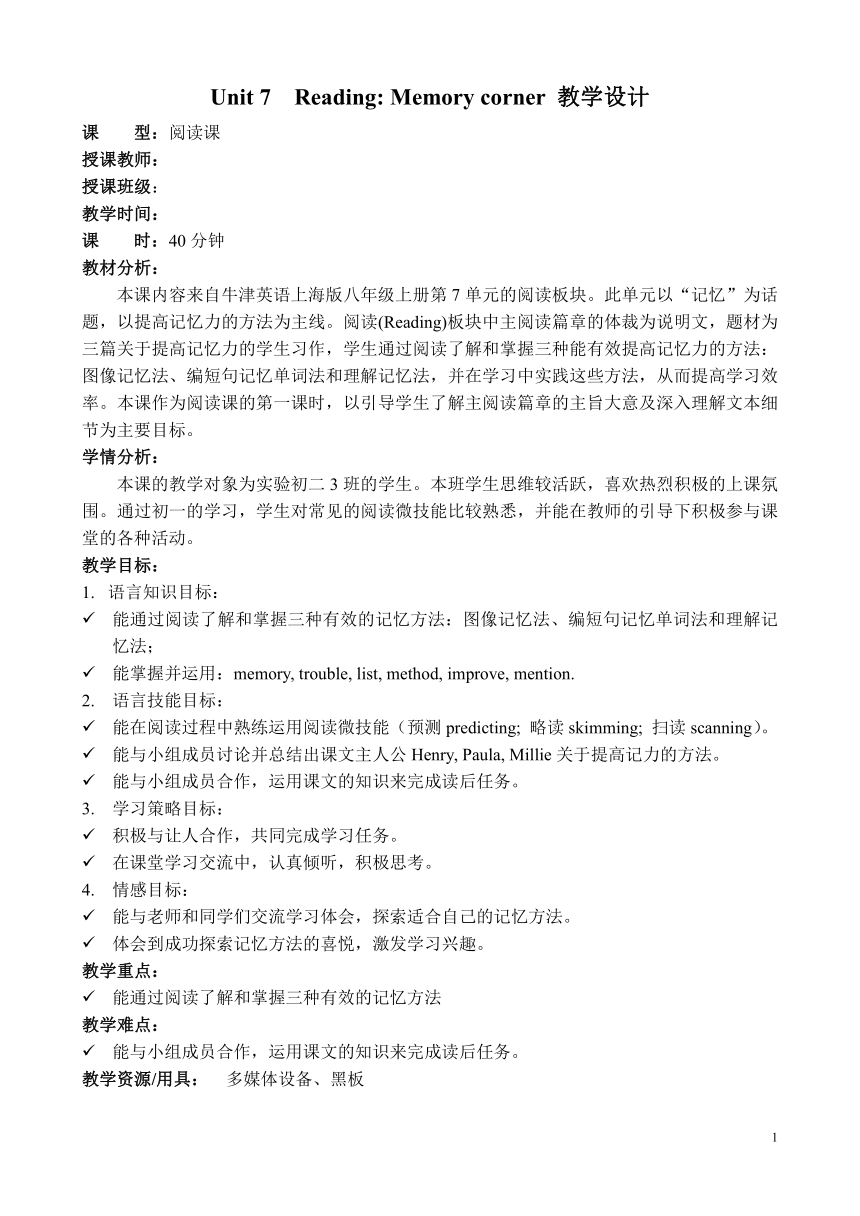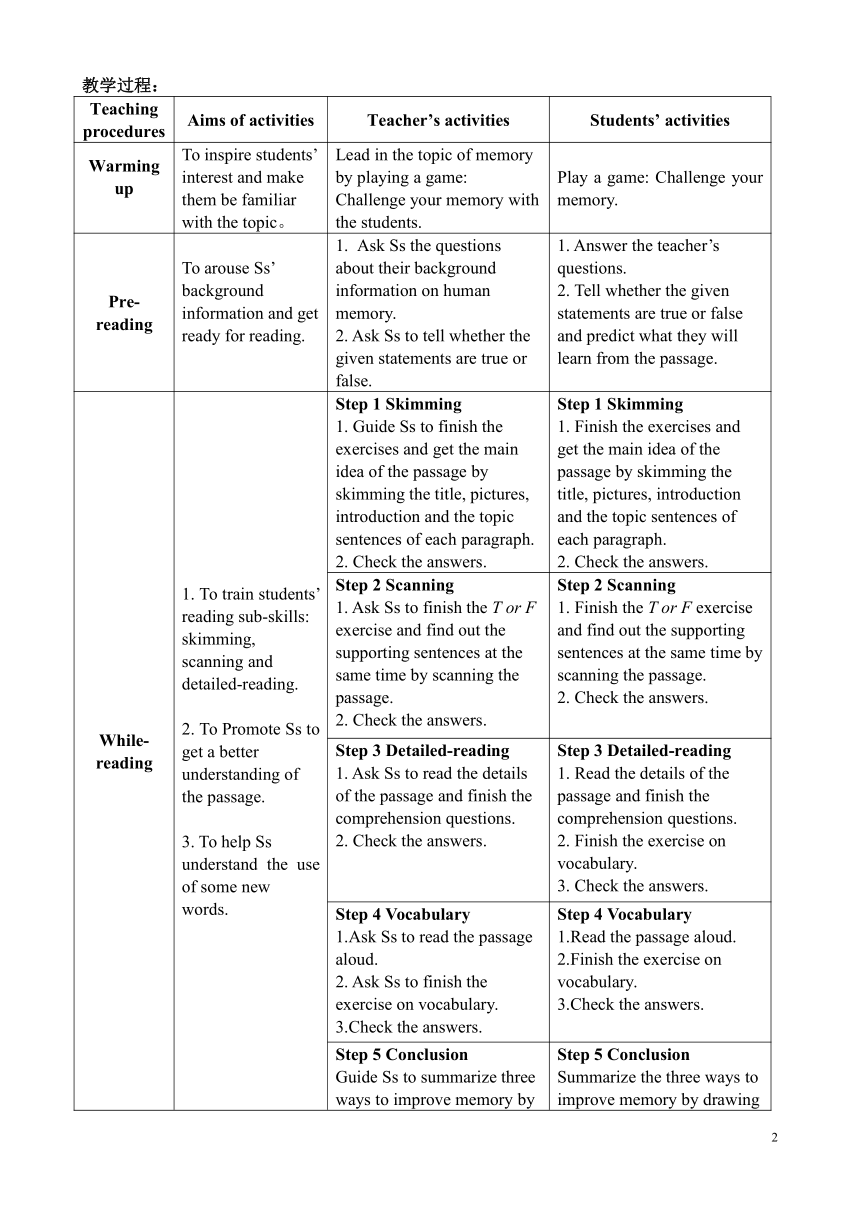牛津深圳版英语八年级上Module 4 School life Unit 7 Memory Reading:Memory corner 教案(1课时)
文档属性
| 名称 | 牛津深圳版英语八年级上Module 4 School life Unit 7 Memory Reading:Memory corner 教案(1课时) |  | |
| 格式 | zip | ||
| 文件大小 | 60.2KB | ||
| 资源类型 | 教案 | ||
| 版本资源 | 牛津深圳版 | ||
| 科目 | 英语 | ||
| 更新时间 | 2021-05-21 09:20:51 | ||
图片预览


文档简介
Unit
7
Reading:
Memory
corner
教学设计
课
型:阅读课
授课教师:
授课班级:
教学时间:
课
时:40分钟
教材分析:
本课内容来自牛津英语上海版八年级上册第7单元的阅读板块。此单元以“记忆”为话题,以提高记忆力的方法为主线。阅读(Reading)板块中主阅读篇章的体裁为说明文,题材为三篇关于提高记忆力的学生习作,学生通过阅读了解和掌握三种能有效提高记忆力的方法:图像记忆法、编短句记忆单词法和理解记忆法,并在学习中实践这些方法,从而提高学习效率。本课作为阅读课的第一课时,以引导学生了解主阅读篇章的主旨大意及深入理解文本细节为主要目标。
学情分析:
本课的教学对象为实验初二3班的学生。本班学生思维较活跃,喜欢热烈积极的上课氛围。通过初一的学习,学生对常见的阅读微技能比较熟悉,并能在教师的引导下积极参与课堂的各种活动。
教学目标:
语言知识目标:
能通过阅读了解和掌握三种有效的记忆方法:图像记忆法、编短句记忆单词法和理解记忆法;
能掌握并运用:memory,
trouble,
list,
method,
improve,
mention.
语言技能目标:
能在阅读过程中熟练运用阅读微技能(预测predicting;
略读skimming;
扫读scanning)。
能与小组成员讨论并总结出课文主人公Henry,
Paula,
Millie关于提高记力的方法。
能与小组成员合作,运用课文的知识来完成读后任务。
3.
学习策略目标:
积极与让人合作,共同完成学习任务。
在课堂学习交流中,认真倾听,积极思考。
4.
情感目标:
能与老师和同学们交流学习体会,探索适合自己的记忆方法。
体会到成功探索记忆方法的喜悦,激发学习兴趣。
教学重点:
能通过阅读了解和掌握三种有效的记忆方法
教学难点:
能与小组成员合作,运用课文的知识来完成读后任务。
教学资源/用具:
多媒体设备、黑板
教学过程:
Teaching
procedures
Aims
of
activities
Teacher’s
activities
Students’
activities
Warmingup
To
inspire
students’
interest
and
make
them
be
familiar
with
the
topic。
Lead
in
the
topic
of
memory
by
playing
a
game:
Challenge
your
memory
with
the
students.
Play
a
game:
Challenge
your
memory.
Pre-reading
To
arouse
Ss’
background
information
and
get
ready
for
reading.
Ask
Ss
the
questions
about
their
background
information
on
human
memory.2.
Ask
Ss
to
tell
whether
the
given
statements
are
true
or
false.
1.
Answer
the
teacher’s
questions.2.
Tell
whether
the
given
statements
are
true
or
false
and
predict
what
they
will
learn
from
the
passage.
While-reading
1.
To
train
students’
reading
sub-skills:skimming,
scanning
anddetailed-reading.2.
To
Promote
Ss
to
get
a
betterunderstanding
ofthe
passage.3.
To
help
Ss
understand
the
use
of
some
newwords.
Step
1
Skimming1.
Guide
Ss
to
finish
the
exercises
and
get
the
main
idea
of
the
passage
by
skimming
the
title,
pictures,
introduction
and
the
topic
sentences
of
each
paragraph.2.
Check
the
answers.
Step
1
Skimming1.
Finish
the
exercises
and
get
the
main
idea
of
the
passage
by
skimming
the
title,
pictures,
introduction
and
the
topic
sentences
of
each
paragraph.2.
Check
the
answers.
Step
2
Scanning1.
Ask
Ss
to
finish
the
T
or
F
exercise
and
find
out
the
supporting
sentences
at
the
same
time
by
scanning
the
passage.2.
Check
the
answers.
Step
2
Scanning1.
Finish
the
T
or
F
exercise
and
find
out
the
supporting
sentences
at
the
same
time
by
scanning
the
passage.2.
Check
the
answers.
Step
3
Detailed-reading1.
Ask
Ss
to
read
the
details
of
the
passage
and
finish
the
comprehension
questions.2.
Check
the
answers.
Step
3
Detailed-reading1.
Read
the
details
of
the
passage
and
finish
the
comprehension
questions.2.
Finish
the
exercise
on
vocabulary.3.
Check
the
answers.
Step
4
Vocabulary1.Ask
Ss
to
read
the
passage
aloud.2.
Ask
Ss
to
finish
the
exercise
on
vocabulary.3.Check
the
answers.
Step
4
Vocabulary1.Read
the
passage
aloud.2.Finish
the
exercise
on
vocabulary.3.Check
the
answers.
Step
5
ConclusionGuide
Ss
to
summarize
three
ways
to
improve
memory
by
drawing
a
spider-.gram.
Step
5
ConclusionSummarize
the
three
ways
to
improve
memory
by
drawing
a
spider-.gram.
Post-reading
1.
To
give
Ss
achance
to
put
theways
they’velearnt
from
thepassage
intopractice.2.
To
help
Ss
knowmore
about
thistopic
by
makingthem
find
moreways
to
improvememory.
Activity
11.
Set
two
examples
to
let
the
Ss
know
how
to
remember
the
words
by
using
Henry’s
and
Paula’s
ways.2.
Give
Ss
more
words
and
ask
them
to
discuss
in
groups
about
how
to
remember
the
given
words
by
using
Henry’s
and
Paula’s
ways.3.
Ask
Ss
to
show
their
ways.
Activity
11.
Discuss
in
groups
about
how
to
remember
the
given
words
by
using
Henry’s
and
Paula’s
ways.2.
Show
their
ways.
Activity
21.
Ask
Ss
to
do
a
survey
about
more
ways
to
remember
words
in
groups.2.
Choose
2
or
3
groups
to
show
their
opinions.
Activity
21.
Do
a
survey
about
more
ways
to
remember
words
in
groups.2.
Share
their
opinions
with
the
whole
class.
Summary
To
help
Ss
have
a
quick
revisionof
this
lesson.
Guide
Ss
to
review
what
they
have
learnt
in
this
lesson.:1.
Reading
skills:
skimming,
predicting,
scanning,
supporting
sentences...2.
Three
methods
to
remember
things
easily.
3.
Some
new
words
and
expressions.
Review
what
they
have
learnt
in
this
lesson.
Homework
To
make
Ss
consolidate
what
they
have
learnt
in
this
lesson.
Assign
the
homework.
Write
a
report
about
the
results
of
your
survey
(about
100
words).
教学流程图:
A?layout?of?the?blackboard:
Aims:
1.
Key
words:
2.
Reading
sub-skills:
1)
_____________
2)
_____________
3)
_____________
3.
Three
ways
to
remember
things:
Let’s
compete!
G1:
G2:
G3:
G4:
G5:
G6:
All
things
are
easy
that
are
done
willingly.
读前(热身+预测)
Pre-Reading
读中(篇章理解)
While-Reading
读后(拓展活动)
Post-Reading
1.
记忆挑战游戏(Game):引入话题,激发学生学习兴趣。
2.
判断正误(T/F):背景知识补充以及文章内容预测。
略读(Skimming)
:通过略读文章标题(title)、引言(instruction)、图片(pictures)及每段第一句(the
first
sentence
of
each
para.),理解文章主旨大意、了解篇章整体结构。
扫读(Scanning):通过扫读,匹配信息并在文章中找出相关句子。
细读(Detailed-reading):仔细阅读文本,深入理解文本内容;并检测学生对核心词汇的掌握情况及对关键信息理解的准确度。
基础活动:将文章所介绍的记忆方法付诸实践,展开联想,记忆新词。
拓展活动:采访现场教师关于词汇记忆的好方法,组内讨论归纳后向全班同学介绍。
总结
Summary
引导学生总结归纳全课所学内容。
作业(巩固)
Assignment
按照今天课堂上关于“词汇记忆好方法”的采访结果,写一篇调查报告。
PAGE
4
7
Reading:
Memory
corner
教学设计
课
型:阅读课
授课教师:
授课班级:
教学时间:
课
时:40分钟
教材分析:
本课内容来自牛津英语上海版八年级上册第7单元的阅读板块。此单元以“记忆”为话题,以提高记忆力的方法为主线。阅读(Reading)板块中主阅读篇章的体裁为说明文,题材为三篇关于提高记忆力的学生习作,学生通过阅读了解和掌握三种能有效提高记忆力的方法:图像记忆法、编短句记忆单词法和理解记忆法,并在学习中实践这些方法,从而提高学习效率。本课作为阅读课的第一课时,以引导学生了解主阅读篇章的主旨大意及深入理解文本细节为主要目标。
学情分析:
本课的教学对象为实验初二3班的学生。本班学生思维较活跃,喜欢热烈积极的上课氛围。通过初一的学习,学生对常见的阅读微技能比较熟悉,并能在教师的引导下积极参与课堂的各种活动。
教学目标:
语言知识目标:
能通过阅读了解和掌握三种有效的记忆方法:图像记忆法、编短句记忆单词法和理解记忆法;
能掌握并运用:memory,
trouble,
list,
method,
improve,
mention.
语言技能目标:
能在阅读过程中熟练运用阅读微技能(预测predicting;
略读skimming;
扫读scanning)。
能与小组成员讨论并总结出课文主人公Henry,
Paula,
Millie关于提高记力的方法。
能与小组成员合作,运用课文的知识来完成读后任务。
3.
学习策略目标:
积极与让人合作,共同完成学习任务。
在课堂学习交流中,认真倾听,积极思考。
4.
情感目标:
能与老师和同学们交流学习体会,探索适合自己的记忆方法。
体会到成功探索记忆方法的喜悦,激发学习兴趣。
教学重点:
能通过阅读了解和掌握三种有效的记忆方法
教学难点:
能与小组成员合作,运用课文的知识来完成读后任务。
教学资源/用具:
多媒体设备、黑板
教学过程:
Teaching
procedures
Aims
of
activities
Teacher’s
activities
Students’
activities
Warmingup
To
inspire
students’
interest
and
make
them
be
familiar
with
the
topic。
Lead
in
the
topic
of
memory
by
playing
a
game:
Challenge
your
memory
with
the
students.
Play
a
game:
Challenge
your
memory.
Pre-reading
To
arouse
Ss’
background
information
and
get
ready
for
reading.
Ask
Ss
the
questions
about
their
background
information
on
human
memory.2.
Ask
Ss
to
tell
whether
the
given
statements
are
true
or
false.
1.
Answer
the
teacher’s
questions.2.
Tell
whether
the
given
statements
are
true
or
false
and
predict
what
they
will
learn
from
the
passage.
While-reading
1.
To
train
students’
reading
sub-skills:skimming,
scanning
anddetailed-reading.2.
To
Promote
Ss
to
get
a
betterunderstanding
ofthe
passage.3.
To
help
Ss
understand
the
use
of
some
newwords.
Step
1
Skimming1.
Guide
Ss
to
finish
the
exercises
and
get
the
main
idea
of
the
passage
by
skimming
the
title,
pictures,
introduction
and
the
topic
sentences
of
each
paragraph.2.
Check
the
answers.
Step
1
Skimming1.
Finish
the
exercises
and
get
the
main
idea
of
the
passage
by
skimming
the
title,
pictures,
introduction
and
the
topic
sentences
of
each
paragraph.2.
Check
the
answers.
Step
2
Scanning1.
Ask
Ss
to
finish
the
T
or
F
exercise
and
find
out
the
supporting
sentences
at
the
same
time
by
scanning
the
passage.2.
Check
the
answers.
Step
2
Scanning1.
Finish
the
T
or
F
exercise
and
find
out
the
supporting
sentences
at
the
same
time
by
scanning
the
passage.2.
Check
the
answers.
Step
3
Detailed-reading1.
Ask
Ss
to
read
the
details
of
the
passage
and
finish
the
comprehension
questions.2.
Check
the
answers.
Step
3
Detailed-reading1.
Read
the
details
of
the
passage
and
finish
the
comprehension
questions.2.
Finish
the
exercise
on
vocabulary.3.
Check
the
answers.
Step
4
Vocabulary1.Ask
Ss
to
read
the
passage
aloud.2.
Ask
Ss
to
finish
the
exercise
on
vocabulary.3.Check
the
answers.
Step
4
Vocabulary1.Read
the
passage
aloud.2.Finish
the
exercise
on
vocabulary.3.Check
the
answers.
Step
5
ConclusionGuide
Ss
to
summarize
three
ways
to
improve
memory
by
drawing
a
spider-.gram.
Step
5
ConclusionSummarize
the
three
ways
to
improve
memory
by
drawing
a
spider-.gram.
Post-reading
1.
To
give
Ss
achance
to
put
theways
they’velearnt
from
thepassage
intopractice.2.
To
help
Ss
knowmore
about
thistopic
by
makingthem
find
moreways
to
improvememory.
Activity
11.
Set
two
examples
to
let
the
Ss
know
how
to
remember
the
words
by
using
Henry’s
and
Paula’s
ways.2.
Give
Ss
more
words
and
ask
them
to
discuss
in
groups
about
how
to
remember
the
given
words
by
using
Henry’s
and
Paula’s
ways.3.
Ask
Ss
to
show
their
ways.
Activity
11.
Discuss
in
groups
about
how
to
remember
the
given
words
by
using
Henry’s
and
Paula’s
ways.2.
Show
their
ways.
Activity
21.
Ask
Ss
to
do
a
survey
about
more
ways
to
remember
words
in
groups.2.
Choose
2
or
3
groups
to
show
their
opinions.
Activity
21.
Do
a
survey
about
more
ways
to
remember
words
in
groups.2.
Share
their
opinions
with
the
whole
class.
Summary
To
help
Ss
have
a
quick
revisionof
this
lesson.
Guide
Ss
to
review
what
they
have
learnt
in
this
lesson.:1.
Reading
skills:
skimming,
predicting,
scanning,
supporting
sentences...2.
Three
methods
to
remember
things
easily.
3.
Some
new
words
and
expressions.
Review
what
they
have
learnt
in
this
lesson.
Homework
To
make
Ss
consolidate
what
they
have
learnt
in
this
lesson.
Assign
the
homework.
Write
a
report
about
the
results
of
your
survey
(about
100
words).
教学流程图:
A?layout?of?the?blackboard:
Aims:
1.
Key
words:
2.
Reading
sub-skills:
1)
_____________
2)
_____________
3)
_____________
3.
Three
ways
to
remember
things:
Let’s
compete!
G1:
G2:
G3:
G4:
G5:
G6:
All
things
are
easy
that
are
done
willingly.
读前(热身+预测)
Pre-Reading
读中(篇章理解)
While-Reading
读后(拓展活动)
Post-Reading
1.
记忆挑战游戏(Game):引入话题,激发学生学习兴趣。
2.
判断正误(T/F):背景知识补充以及文章内容预测。
略读(Skimming)
:通过略读文章标题(title)、引言(instruction)、图片(pictures)及每段第一句(the
first
sentence
of
each
para.),理解文章主旨大意、了解篇章整体结构。
扫读(Scanning):通过扫读,匹配信息并在文章中找出相关句子。
细读(Detailed-reading):仔细阅读文本,深入理解文本内容;并检测学生对核心词汇的掌握情况及对关键信息理解的准确度。
基础活动:将文章所介绍的记忆方法付诸实践,展开联想,记忆新词。
拓展活动:采访现场教师关于词汇记忆的好方法,组内讨论归纳后向全班同学介绍。
总结
Summary
引导学生总结归纳全课所学内容。
作业(巩固)
Assignment
按照今天课堂上关于“词汇记忆好方法”的采访结果,写一篇调查报告。
PAGE
4
